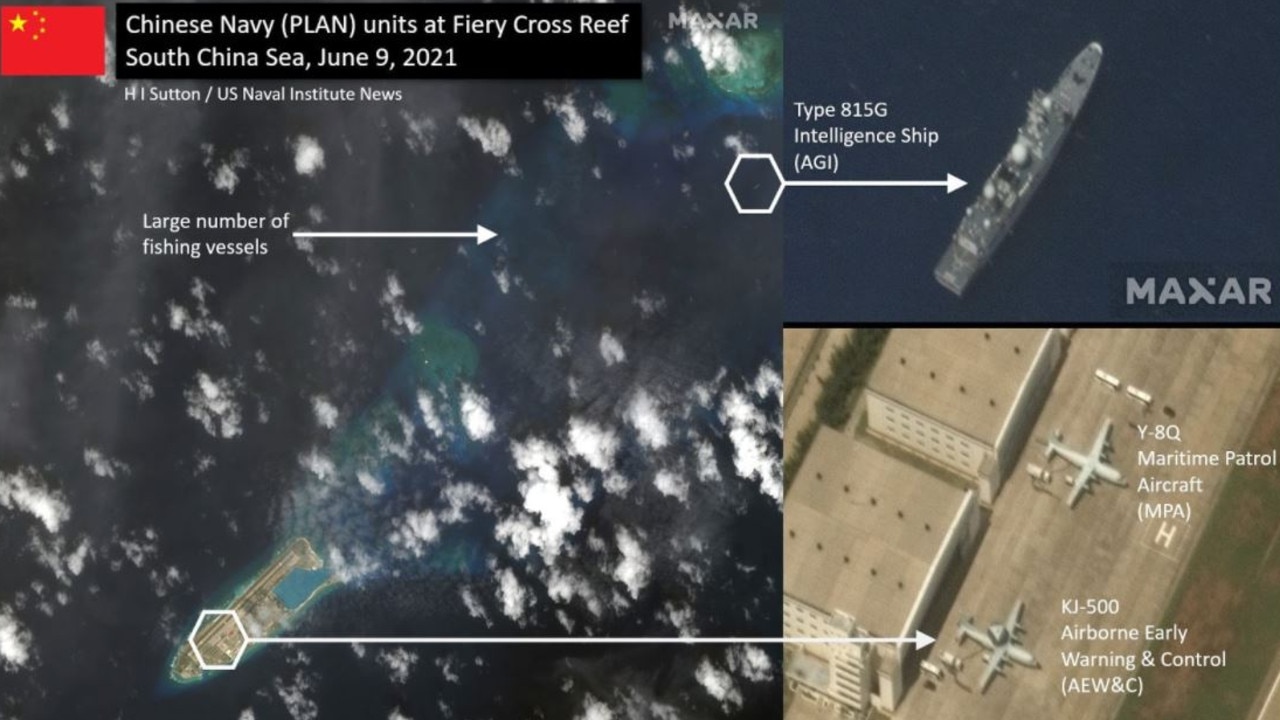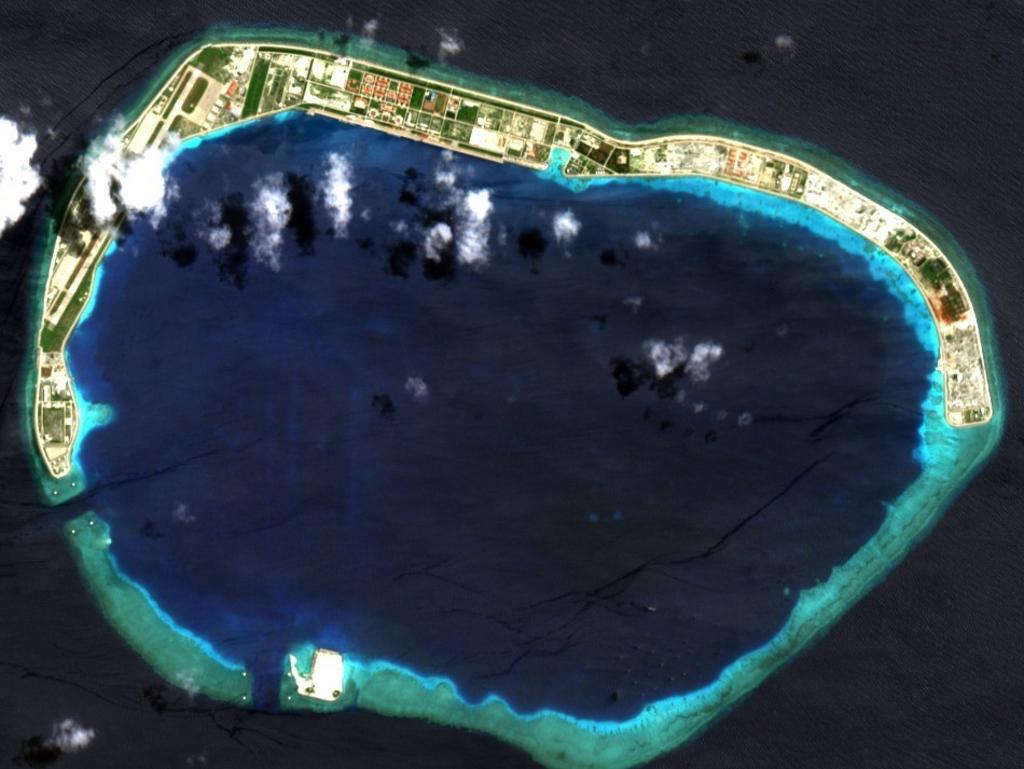China builds new Great Wall as global sea conflict escalates
China insisted it would never happen but satellite photos have revealed they have broken their promise and it’s all part of a deadly “feedback loop”.
Chairman Xi Jinping insisted it would never happen. But it has. China has permanently stationed combat aircraft on its illegal artificial island fortresses in yet another South China Sea escalation.
Y-8Q anti-submarine patrol and KJ-500 airborne early warning & control (AWAC) aircraft were spotted by the US Naval Institute in May.
It didn’t seem entirely unusual. Such aircraft had dropped in on the islands before.
Now John Hopkins University analyst and former naval intelligence officer Michael Dahm says new satellite photos show the deployment appears permanent.
And that’s significant.
It indicates “the PLA may have commenced routine air operations from those airfields,” he told The Washington Times.
China in 2015 insisted that it was simply building safe havens and rescue facilities for commercial fishing and shipping on the Paracel and Spratly Island reefs.
RELATED: US trolls China with new secret bomber

RELATED: Satellite pics reveal China’s secret
Then the enormity of the airfields became apparent along with bombproof hangars, underground ammunition dumps and gun towers. Beijing sought to diffuse the situation by insisting it had no intention of “militarising” the facilities with permanently stationed combat aircraft or warships.
But now they’re there.
“This shows that China is attempting to increase its control over the region,” Australian Institute of International Affairs (AIIA) national executive director Dr Bryce Wakefield told news.com.au. “These aircraft will allow China to use assets in the region more effectively, its so-called maritime militia, for example, to wage their campaign of harassment in scenarios short of war.”
China’s sand castles
The “routine” operation of military surveillance aircraft off artificial island fortresses in the South China Sea proves Beijing is in no mood to back down on its territorial ambitions.
And international security analysts say such ongoing increases in military activity reveal a deadly “feedback loop” between China and the United States.
Every few months, Beijing makes another small move to assert its authority over the contested sea. Washington then responds with its own increased military presence.
“The most significant change in military posture in 2021 is the appearance of Chinese special mission aircraft and helicopters at Subi and Mischief Reefs,” says Dahm.
RELATED: China moves in on Afghanistan

Even more significant is how it contradicts Chairman Xi’s 2015 pledge.
“Relevant construction activities that China are undertaking in the Nansha (Spratly) Islands do not target or impact any country, and China does not intend to pursue militarisation,” Xi declared after satellite photos revealed the military nature of the artificial island facilities.
The excuse was the islands were dual-use – civilian rescue facilities able to handle military equipment.
It offered China plausible deniability.
The lie was exposed as soon as 2016 when satellite photos revealed fortified gun and missile towers.
But the diplomatic facade persisted.
“China has deployed AWACS to Mischief Reef before, but it seems that this is now a more regular, permanent deployment,” Dr Wakefield says.
A new ‘Great Wall’
The stationing of modern combat aircraft on the islands realises a long-held fear.
Their presence will “fill critical gaps in PLA navy capabilities in the South China Sea, especially in terms of reconnaissance and airpower,” Dahm says.
Beijing’s arbitrary move to seize and fortify South China Sea reefs a decade ago marked a significant turning point in its international standing.
Suddenly, the world’s eyes focused on the expanding People’s Liberation Army (PLA) air force, navy, marine corps and rocket force. Not to mention the assertive territorial ambitions being touted by Beijing’s “Wolf Warrior” diplomats.
The arrival of surveillance aircraft represents a dramatic uptick in the steady increase in combat power assembled on the islands.
While one step removed from frontline combat aircraft, the KJ-500 AWACS offer broad radar coverage and can direct fighters, bombers, warships and submarines to remote targets.
PLA released clip of an interception over the South China Sea in May 2020. At that time, some B-1B bombers conducted several operations over the South China Sea as part of BTF mission. There is rare footage of Chinese fighter jets flying over Mischief Reef in this clip. pic.twitter.com/VOadLDro9x
— Duan Dang (@duandang) June 20, 2021
Likewise, the Y-8Q ASW aircraft can locate, target and drop torpedoes on submarines and missiles on surface ships. Also seen on the islands are Z-8 multirole helicopters. These are capable of short-range anti-submarine warfare and troop deployment.
The fortresses themselves house HQ-9 anti-aircraft missiles and YJ-12 anti-ship cruise missiles within concrete emplacements. But the artificial islands are capable of much more.
Their 2.7km long runways can operate the largest and heaviest aircraft in the PLA’s arsenal, including H-6 strategic bombers and Y-20 heavy-lift aircraft. Their hardened hangars can house both these and dozens of smaller strike fighters and interceptors.

Dr Wakefield, however, is more sceptical of the strength of these island fortresses.
“Should conflict break out in the region, the positioning of military assets on features like Mischief or Subi reefs might give China an advantage very early on,” he says. “However, their strategic utility would rapidly diminish given their extreme vulnerability. These deployments are therefore likely more aimed at supporting activities that strengthen Chinese claims in the region.”
Not in my backyard
China this week sent one of its spy ships to watch a fortnight-long war game underway in Queensland involving Australian, US, South Korean, Japanese and UK forces.
“Canberra should learn to adapt to the new normal”, the Communist Party’s Global Times news service states. “Chinese ship in international waters nearby Australia has no intention to provoke Canberra. It has appeared out of reasonable concern for unfriendly military exercises that take China as an imaginary enemy.”
But, at the same time, it’s protesting the presence of US surveillance ships in the South China Sea’s international waters.
AIS data reveals that the U.S. has been successively deploying all of its 5 ocean surveillance ships into the sensitive waters of the #SouthChinaSea on an almost daily basis, in the first half of 2021. pic.twitter.com/7bxXSlLnmB
— SCS Probing Initiative (@SCS_PI) July 14, 2021
A Beijing University think-tank says five such ships – the USS Victorious, Able, Effective, Loyal and Impeccable – are stationed in Japan. These are now active in “the sensitive waters of the South China Sea on an almost daily basis,” it says.
“(They are there) to monitor the dynamics of China’s underwater forces, analyse the scope of submarine activities in key waters and their entry and exit routes, and provide intelligence support for anti-submarine operations,” the South China Sea Strategic Situation Probing Initiative (SCSPI) report says.
Likewise, Beijing’s basing of surveillance aircraft on the Paracel and Spratly Island fortresses will enhance their ability to monitor US surface ships, aircraft and submarines.
The main difference is they potentially have the firepower to force them out of the region.
“US and allied militaries must either rapidly develop new, long-range strike capabilities or develop tactics to manoeuvre within range of Chinese targets without being detected and struck first by long-range PLA weapons,” Dahm warns.
Offensive moves
As recently as Monday, US Secretary of State Antony Blinken expressed the United States’ growing anger towards Beijing.
“Nowhere is the rules-based maritime order under greater threat than in the South China Sea,” he said. “The People’s Republic of China (PRC) continues to coerce and intimidate Southeast Asian coastal states, threatening freedom of navigation in this critical global throughway.”
On Monday, the United States sent one of its warships on an “innocent passage” path through waters claimed as territorial by Beijing. The US doesn’t accept that claim.
Monday was the anniversary of the International Arbitration Court ruling that deemed China’s claims over the Spratly Islands invalid.
The guided-missile destroyer USS Benfold passed through the Paracel Islands in the northern part of the South China Sea.
Latest position: One day after the FONOP, USS Benfold is spotted at about 34.7 NM northwest of the Paracel Islands, 02:32 AM UTC, Jul 13.
— SCS Probing Initiative (@SCS_PI) July 14, 2021
Image credit to @lobsterlarryliu via @planet. pic.twitter.com/OT8Fpvieta
“Innocent Passage” is a provision in the international law of the sea that allows warships to enter territorial waters during peacetime – so long as it is on a straight-line path to its objective. However, it also specifies that this should not be used as a means of challenging territorial claims.
Washington says it is not challenging any claim and is merely exercising its rights.
Beijing, of course, has a different view.
The islands are “China’s inherent territory,” the PLA declared in a statement condemning the passage on Monday. “The actions of the US military have seriously violated China’s sovereignty and security.”
Beijing says it “chased” the USS Benfold out of the Paracels.
Washington says the ship was simply passing through anyway.
Jamie Seidel is a freelance writer | @JamieSeidel




